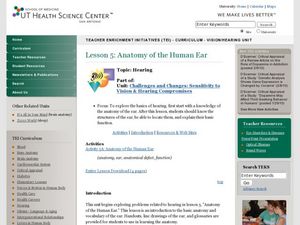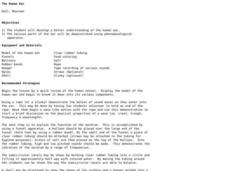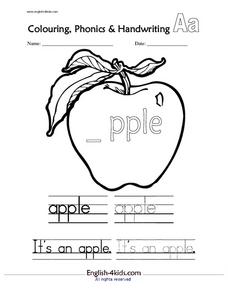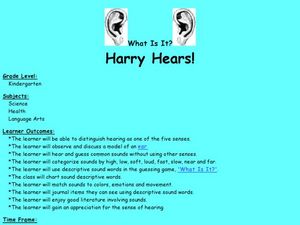Core Knowledge Foundation
The Human Body—Systems and Senses Tell It Again!™ Read-Aloud Anthology
Nine lessons over three weeks explore the human body through read-alouds. Third graders listen to and discuss a reading followed by extension activities, including word work and comprehension practice. Learners draft a narrative essay.
Scholastic
Study Jams! The Senses: Hearing
How does this sound? It's a rockin' video starring two teenage girls talking about music, hearing, and the ear. Listeners hear that the ear does not only gather sound waves, but also helps us maintain balance. They also will get an...
University of Minnesota
Balance: The Ears Have It
Don't go around and around with the same concept! A hands-on activity explores the vestibular system and circular motion. After spinning a group member, lab partners examine their eye movement. Making observations allows the group to...
Magic of Physics
Ears and Hearing
One of the few body parts that self-cleans, ears contain three sections and many different parts. An interactive displays each section with a description of the importance of every part. Users discover how hearing and balance both rely...
Howard Hughes Medical Institute
Explore Your Inner Animals
Human bodies prove evolution thanks to our genes, bones, and more. Learning about specific body parts and how they evolved from other species helps individuals better understand the transition species that helped us become who we are today.
Science Friday
Make a Model Eardrum to Detect Sound Waves
Make sound waves visible with an experiment that asks middle schoolers to build a model ear drum using plastic bottles, rubber bands, plastic wrap, and sand-like substances.
Curated OER
The ea and ear sounds
Focus on the /ea/ and /ear/ sounds. Learners complete three sentences by adding the appropriate ea word from a word bank, re-writing each sentence. Then, they read an excerpt from Little Red Riding Hood and find all the words with...
Curated OER
Body Parts Worksheet: Ears
Hre is an ESL and printing practice worksheet. Learners trace six examples of the word "ear" before forming their own words on the primary lines. They color the pictures of the ears.
Curated OER
A Story About the Ear
Travel through the ear! Use this comprehensive presentation to cover hearing, hearing loss and the treatments paired with different types of hearing loss. Slides are too text-heavy for learners to copy, so provide them with a partially...
Curated OER
Funny Ears
Young scientists get a worksheet that has a picture of a dog, a donkey, a person, a mouse, a rabbit, and a cat. Each picture has the wrong ears attached to it! Learners must draw lines matching up the ears with the correct recipient. The...
Curated OER
Science Crossword Puzzles: The Ear
Employ this crossword puzzle as a review activity for ear anatomy. Pupils use 8 clues about the anatomy of an ear to solve the puzzle. Answers are not included with this learning exercise; however, since there are only 8 words, it should...
Curated OER
Anatomy of the Human Ear
Young scholars examine the human ear and its function. In this anatomy of the human ear lesson plan, students view drawings of the ear and learn about the structure of the ear through handouts and glossaries. This lesson plan is part of...
Curated OER
Now Hear This!
Students create a model of the inner ear. In this hearing lesson plan, students follow a series of directions to build a working model of the inner ear, then observe how the parts react to a variety of sounds.
Curated OER
The Human Ear
Learners explore the human ear. For this biology lesson plan, students develop a better understanding of the various parts of the human ear as they explore a hands-on apparatus.
Curated OER
Handwriting Practice: I Have Two Ears
In this ESL and handwriting worksheet, students trace two examples of the sentence "I have two ears." Students use the blank primary lines to practice writing this sentence and then color the pictures.
Curated OER
TE Activity: Sound Line
Students investigate the decibel readings of various noises. They determine why high-level readings damage hearing. Students arrange sound from the lowest to highest decibel levels when they written on a piece of paper.
Curated OER
Telecommunication
Each of these slides has notes for a teacher to support the activities that are planned for the students. The slides give details and facts about sound waves. Although this slide show delivers useful information about the sound waves,...
Curated OER
Ear Parts
In this ear parts activity, students match parts to definitions and label an ear diagram. Students complete 12 problems on this activity.
Curated OER
Genes
In this genes worksheet, students answer yes or no to questions about their genes involving their tongue, ears, eyes, and fingers. Students complete 4 questions.
Curated OER
Ears
In this ears worksheet, students trace and write the word ears. Students trace the word 6 times each, and write the word 3 times each. Students can also color the ears.
Curated OER
Harry Hears!
Pupils explore ear anatomy and the sense of hearing. In this hearing lesson, students discuss the five senses and view a model of an ear. Pupils place cotton balls in their ears to simulate loss of hearing. Students use descriptive words...
Curated OER
The Ear
In this ear anatomy worksheet, students complete an on-line interactive exercise. Students analyze a detailed diagram of the ear. Students drag the names of ten parts of the ear to the correct spot on the diagram.
Curated OER
Ears Help Us
In this biology worksheet, students draw pictures of how ears help us. They illustrate ears being use for communication, relaxation, happiness, and for safety.
Curated OER
The Senses
In this senses worksheet, students describe the difference in sounds heard with a spoon. Then they describe how each object creates a sound and why. Students also explain the process of sound moving through the outer and inner ear.

























